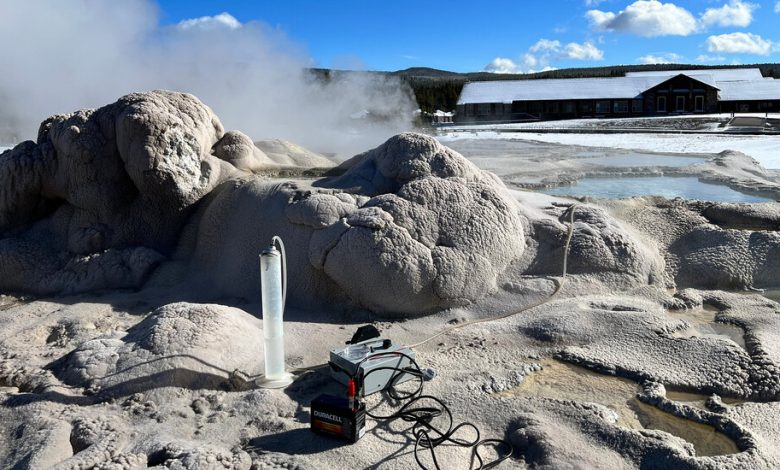Old Faithful Is Boiling, Smelly and the Perfect Home for These Living Things

Yellowstone National Park is a North American hot spot for wildlife. The park’s mountains, forests and meadows are home to the largest concentration of mammals in the lower 48 states, including the native bison and a restored population of gray wolves. Millions of visitors flock to the park each year, waiting for a glimpse of the diverse wildlife.
It turns out that other popular features at Yellowstone — hydrothermal springs, pools and geysers that steam and bubble — are also a unique habitat for living things. Instead of charismatic mammals and birds, they are home to chaos-loving microbes.
Scientists have long studied the hydrologic features of Yellowstone’s springs and pools, “but nobody has ever studied the microbiology of a geyser,” said Eric Boyd, a professor of microbiology at Montana State University.
One reason they were ignored? Geysers are volatile. Old Faithful, a popular draw at Yellowstone, erupts every 90 minutes or so, shooting boiling water 100 feet or more toward the sky. The water tumbles through the cold-by-comparison air, plunges, then sinks back into the hot pools below.
It was hard to comprehend that anything could survive this brutal cycle. But in research presented last week at the Geological Society of America annual meeting, Dr. Boyd and colleagues showed that Yellowstone’s geysers are perfect homes for some tiny creatures.
To test the waters, the team captured falling liquid during Old Faithful’s eruption. Back in the lab, the samples were doused with a chemical designed to make tiny microbes fluoresce.
“We saw cells, and that was really exciting,” Lisa Keller, a doctoral candidate at Montana State, said. “But we needed to rule out that that wasn’t contamination because we’re catching water that’s flying through the air.”
After feeding the microbes and heating up the Old Faithful samples to their home temperatures, there was a flurry of activity at around 195 degrees Fahrenheit and a glimmer of action at 160 degrees. Ms. Keller explained that this showed the microorganisms were not only acclimated to the higher temperatures, but that they also preferred the heat.
The team used DNA testing to identify the microorganisms living in the vents and pools of the geyser. Thermocrinis, a group of bacteria species that loves heat and converts chemicals to energy, made up more than 60 percent of the microbes at Old Faithful. Members of two other heat-loving microorganism genuses, Thermus and Pyrobaculum, added to the plume’s microdiversity.
The researchers “correlated the different groups of microorganisms to different environmental conditions, which is very cool,” said Alfonso Davila, an astrobiologist at NASA Ames who was not part of the study. He said the work showed that a diverse microbiome could develop within a relatively small geyser system.
The team suggested that the diversity was driven by the dynamic environment at Old Faithful, which provides everything that some microbes need to thrive: sulfur compounds, carbon and steamy water.
Supporting their hypothesis, Ms. Keller noted that calm pools with no turbulent eruptions had much less population-level biodiversity than they saw in the geyser.
“The geyser is a hostile, inhospitable environment. Yet, it’s almost like a cradle for biodiversity,” Dr. Boyd said, adding that in the sulfurous, volcano-heated, carbon-dioxide-laden waters of Old Faithful, Thermocrinis is “happy as a clam.”
And what about geysers beyond our home planet? Evidence of geysers on Saturn’s ice-covered ocean moon, Enceladus, and Jupiter’s moon Europa could host the conditions needed for microbes to prosper. Finding evidence off Earth is not far-fetched.
Discovering life in Old Faithful helps astrobiologists better understand life in such extremes, Dr. Davila said.
“The fact that life can grow on Earth in those particular conditions tells us something about the biological potential” in places like Enceladus, Europa or even Mars, he said.
While it may be many years before scientists get a look at potential evidence of life in those far-off worlds, here at home we have Yellowstone, which Dr. Boyd said is home to half of the roughly 1,000 geysers in the world. And the more scientists study geysers in Yellowstone and other parts of the world, the more they may find.
“I would put my money that any geyser we sample on Earth will support microbial life,” Dr. Boyd said.




